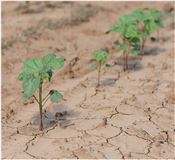AgCenter-led team receives grant to help farmers irrigate efficiently
OLIVIA MCCLURE
BOSSIER CITY, LOUISIANA
When drought conditions set in across Louisiana this summer, many farmers resorted to irrigation to try to save their crops. While it helped preserve yields and quality in some cases, the sharp uptick in irrigation raised alarm among those who monitor water usage in agriculture.
With concerns about the sustainability of water supplies in mind, LSU AgCenter engineer Stacia Davis Conger is leading a team to develop an irrigation decision-making app and outreach campaign aimed at helping farmers mitigate drought risks in an environmentally and economically responsible way. She recently was awarded a $295,860 grant from the U.S. Department of Agriculture to support the work.
“The long-term goal of this project is to inspire behavioral change in overall water consumption,” said Conger, who is based at the AgCenter Red River Research Station in Bossier City.
The grant she received is part of a larger effort of the USDA National Institute of Food and Agriculture to “rapidly deploy strategies and fill knowledge and information gaps to protect the nation’s food and agricultural supply chains — from production through consumption — during and after extreme weather and disasters,” according to an announcement from the institute.
Conger, along with co-principal investigators Carol Friedland and Robert Rohli, is working on an app that will provide farmers site-specific irrigation recommendations based on current drought and hydrological conditions. By pinpointing areas of fields that need water most and helping determine the timing of irrigation events, this tool will allow farmers to become more efficient, she said.
Friedland, director of the AgCenter LaHouse Home and Landscape Resource Center, has extensive experience with mitigating environmental risks such as drought, flood, tornadoes and wind damage. Rohli, a professor in the LSU College of the Coast and Environment who specializes in climate and weather, is assisting on methods for estimating evapotranspiration, which is a major driver of determining irrigation requirements.
Making the best use of increasingly limited water resources is important.
“Excessive irrigation at unsustainable rates may render water resources as environmentally or economically unavailable,” Conger said.
Agriculture is responsible for about 38% of water usage nationally, she said, adding that irrigation has been on the rise in the South for nearly two decades. In Louisiana, there is growing concern about the long-term viability and quality of aquifers, which supply much of the state with water.
Recent climate trends have exacerbated these issues.
“Louisiana is the most vulnerable U.S. state to extreme weather events due to its high frequency of natural disasters including flood, hail, lightning, tornadoes, drought, extreme heat and extreme cold,” she said. “Of these hazards, drought is the most expensive risk to Louisiana agriculture, accounting for 95% of project crop losses by 2050.”


Young cotton plants emerge from dry, cracked soil. LSU AgCenter file photo